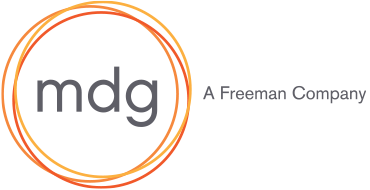
If you’re still sorting through the (seemingly) infinite number of online event platforms to find the right one, you’re not alone. Evaluating all the promises of enhanced networking, engaging content delivery, facilitated commerce, new sponsorship opportunities and more can become a full-time job. At mdg, we’ve developed a process that utilizes 5 “P”s to measure virtual event platforms’ strengths, weaknesses and overall ability to deliver on attendee and exhibitor expectations.
PURPOSE. Why does your event exist? To engage your audience until physical events resume? To maximize revenue? To keep your industry suppliers connected to buyers? To provide CE credits? To build community? Too often we see a rush to technology that ignores the fundamental considerations of the event itself. The answers to these “purpose” questions will define the functionality you need, whether it’s for an advanced marketplace, flexible engagement before and after an event or solutions that create a personalized experience through AI-driven matchmaking and recommendation engines.
PEOPLE. A thorough understanding of your audience, their needs and their preference for receiving information will build upon the first “P” and is essential to choosing the best platform. For example, if education and content are the priorities, focus on live streaming, UX-friendly platforms, on-demand capabilities and support. If audience engagement is what you are going for, focus on features like Q&A, live polls, open chat and social media conversations. If delivering value to exhibitors is important, place more emphasis on the online marketplace. Knowing your audience’s expectations will help you formulate a plan to exceed them.
PRICING. Since pricing models vary by number of attendees, levels of customization, service agreements and license length, it’s likely you’ll end up with a custom quote. Before you get there though, approach the demo process with a solid understanding of the pricing tiers of the various platforms so that you’re not wasting your time with unrealistic options. After determining what features are priorities and which are “nice to haves,” you can assess if certain functionalities are worth the investment.
PERFORMANCE. There’s no perfect platform, and not every platform fits every event. Most promise the same foundational set of features, including live and on-demand content, seamless networking capabilities and enhanced sponsor ROI. Identifying strengths and weaknesses of leading platforms and aligning them to your audience and organizational priorities will help you narrow down your options. As a result, you’ll spend less time on demos that aren’t relevant and more time testing the performance of a curated list of possibilities. You may also find that to get the kind of performance you expect, you have to combine multiple solutions.
PRODUCTION. Even with the ideal platform, you may need additional production support to optimize your event. Some platforms offer services such as attendee acquisition, programming support, video production, custom designs, day-of technical support and overall project management. More often than not, however, you’ll need to pair several partners and solutions to deliver the best virtual experience possible.
Tyler Day is a senior member of the virtual event marketing team at mdg. He works with clients to find and customize the right technology solutions to create engaging, memorable and profitable digital experiences.


